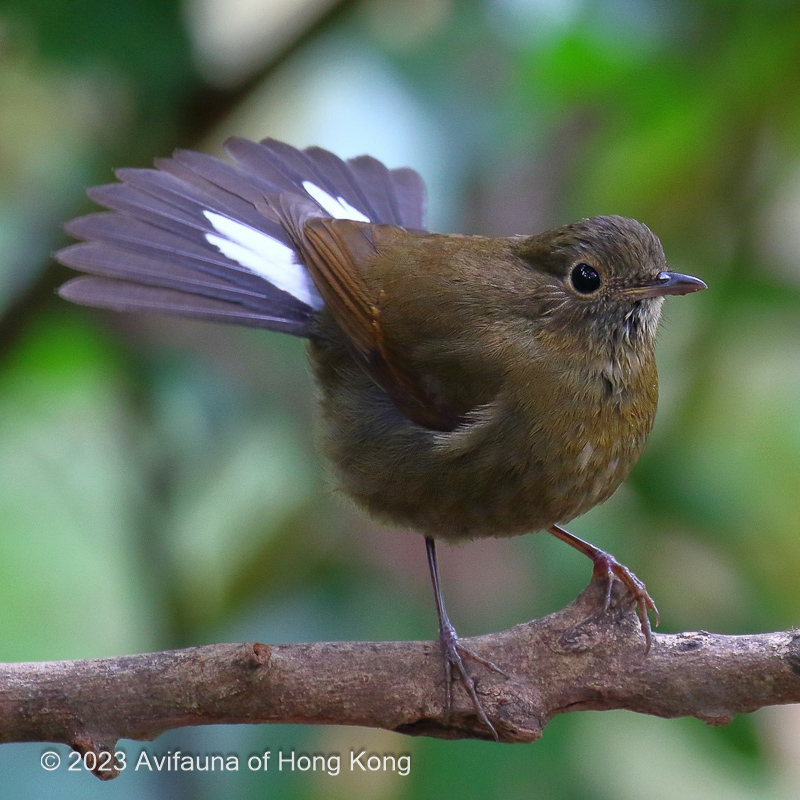White-tailed Robin Myiomela leucura 白尾藍地鴝
Category I. Scarce winter visitor, now apparently annual.
IDENTIFICATION

Feb. 2023, Michelle and Peter Wong.
17-19 cm. Secretive and shy. The male often appears all black when it is observed skulking deep in the understorey or shrub. With good views, however, the overall plumage is dark blue with a contrasting pale blue forehead and shoulder. The prominent, long white patches at the base of the full tail are diagnostic.

Dec. 2012, Kenneth Lam.
The female is brown and rather non-descript but shares with the male diagnostic white patches in the tail.
VOCALISATIONS
The typical calls are a high-pitched ‘tsee’ and rather loud, low-pitched ‘tuk’, sometimes uttered in tandem.
The song, which is rarely heard in HK, is a short but loud, metallic and somewhat haunting phrase.
DISTRIBUTION & HABITAT PREFERENCE
Occurs in wooded habitats with a suitably dense understorey. Several records occurred in the Tai Mo Shan massif, but it has also occurred at Pak Sha O, Lung Fu Shan and Cheung Chau, as well as at migration sites such as Mt Davis and Ho Man Tin.
OCCURRENCE
As the first occurrence involved an adult male trapped at Kadoorie Agricultural Research Centre on 11 November 1990 that showed obvious signs of captivity, the second, a male at Tai Po Kau on 23 January 1993, was viewed with caution and the species remained in a category for ex-captive species.
There were no further sightings until the 2003/04 winter, after which there was a further gap in records until winter 2011/12. After this, however, sightings became more regular, and in 2014 the species was placed in Category I. The male at Tai Po Kau in January 1993 became the first accepted record of a wild bird in HK, and the second was a male at Tai Po Kau between 11 January and 22 February 2004.
Apart from the 2016/17 winter, it has been noted each winter period since 2011/12 and, although still clearly a rare visitor, sightings are increasing with a high count of five individuals in winter 2019/20.
All records have been of single birds. Of the 18 individuals noted since 1993, ten were recorded on only one day. Some, however, remained over a longer period, notably a female at Pak Sha O from 29 December 2014 to 7 March 2015.
Extreme dates of occurrence are 24 October and 7 March. Most sightings have been from the third week of November to the third week of February. There is only one October record - a male at Ho Man Tin on 24 October 2018, presumably a passage bird. The only record for the last week of February and the first week of March involved the long-staying bird at Pak Sha O.
BEHAVIOUR, FORAGING & DIET
Secretive and shy. Forages on the ground, usually in dense vegetation. Occasionally spreads tail exposing white tail-bases.
RANGE & SYSTEMATICS
Three subspecies are recognised. Nominate M. l. leucura breeds above 1,000m from central Nepal to northeast India, east to central China and south through Indochina to peninsular Malaysia and Hainan. In China it occurs north to southeast Gansu and south Shaanxi, south to southeast Tibet, Sichuan, west Hubei, central and southwest Yunnan, Hainan, southeast Guangxi and northern Guangdong. It is usually regarded as sedentary or a short-distance altitudinal migrant but records from HK may indicate that some longer movement takes place. M. l. montium is resident in Taiwan. M. l. cambodiana is resident in southeast Thailand and Cambodia (Clement and Rose 2015, Collar et al. 2020, Liu and Chen 2020).
CONSERVATION STATUS
IUCN: Least Concern. Population trend decreasing.
Clement, P. and C. Rose (2015). Robins and Chats. Christopher Helm, London.
Collar, N., J. del Hoyo, D. A. Christie, and G. M. Kirwan (2020). White-tailed Robin (Myiomela leucura), version 1.0. In Birds of the World (S. M. Billerman, B. K. Keeney, P. G. Rodewald, and T. S. Schulenberg, Editors). Cornell Lab of Ornithology, Ithaca, NY, USA. https://doi.org/10.2173/bow.whtrob2.01
Liu, Y. and Y. H. Chen (2020). The CNG Field Guide to the Birds of China (in Chinese). Hunan Science and Technology Publication House.

